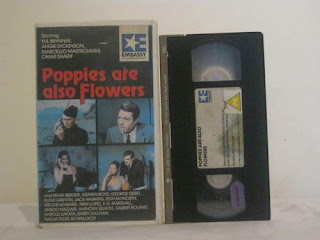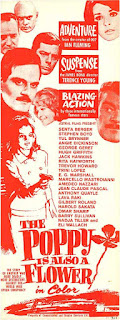U.S One Sheet Poster
Poppies Are Also Flowers (aka Danger Grows Wild), is a crime drama of sorts, billed as a French/Austrian/American co-production and shot in English. It features an all-star cast, including (in addition to Jocelyn) Senta Berger, Stephen Boyd, Yul Brynner, Angie Dickinson, Hugh Griffith, Rita Hayworth, Trevor Howard, E.G. Marshall, Marcello Mastroianni, Nadja Tiller, Eli Wallach, Oma Sharif, Grace Kelly, Marilu Tolo, and Howard Vernon. The general storyline is that two narcotics agents (I suppose) of the United Nations are trying to track down a shipment of drugs that originated from poppies grown in Iran. The poppies had been injected with radiation, and the intent was to follow the shipment in order to identify the network of drug dealers. The U.N. lost track of the shipment, however, before it made it out of Iran, so the two agents (Howard and Marshall) try to find it across Europe through the radioactivity angle. I'm not going to spend more time describing the plot, because this film is terrible.
How could a movie that was shot in places like Iran, France, Monte Carlo, and Italy with an all-star cast, in a story inspired by Ian Fleming and directed by Terence Young (after he had already directed Dr. No, From Russia With Love, and Thunderball) gone so wrong? The movie even has the guy that played Oddjob in Goldfinger (Harold Sakata) appearing in a bad guy role. I don't know what went wrong, but it did. Perhaps the U.N. involvement had something to do with it. The film even had retired Grace Kelly delivering an opening monologue. Despite the locations and all of the stars, this is a mess of a movie, boring and ugly (despite the exotic locales). I initially tried to watch it a few years ago and gave up, because I couldn't stay awake. I watched it all the way through this time in preparation for this post, and it was not any better. If I were developing a top ten list of movies that were turkeys, this one would definitely be on it. For crying out loud, if you've got Jocelyn Lane, Angie Dickinson, Senta Berger, Nadja Tiller, Rita Hayworth, etc. in a movie and can't make it interesting, then the train has definitely gone off the track somewhere.
In an effort to say something positive, the last 20-30 minutes of the film are better than the rest. Howard's falling into the hands of the drug kingpin is rather jolting and well-done.
My recommendation is not to waste your time on this film, unless you are just a big fan of one of its stars and can't stand to miss it. Don't say I didn't warn you, though. If you only care about seeing Jocelyn at work, skip to about the 66-minute mark. She plays a photographer/reporter who is in a Monte Carlo club to cover a Trini Lopez show, and she briefly appears within about a 5-minute sequence, delivering 2 or 3 lines of dialogue in a French accent (which she did quite well). Since it is unlikely that I will ever locate any publicity stills or other material featuring Jocelyn from this film, here are a few screen caps to show what she looked like in this very small role.



The film was financed as a one-time television special by Xerox and made under the Telsun (Television Series for the United Nations) Foundation aegis for the United Nations and then acquired by distributors for theatrical release. I guess it was intended to be sort of a public-service anti-dope film, with proceeds going to a UN charity (UNESCO). Apparently the stars worked free of charge (or for a nominal $1 salary). Filming commenced around the first of October of 1965 and was completed in the early part of 1966 after shooting in several locations across Europe. Based on a note in Variety, it appears that Jocelyn did her work around the first week of October. The final cost as the project grew was reported to have been about $1.8 million, with $600,000 coming from Pacsun and $1.2 million coming from Wiener Stadhalle (Austria's largest event center, which acquired worldwide distribution rights). I'm not sure how the Xerox financing played into the total.
The film premiered in the U.S. in an
80-minute Xerox-sponsored version on ABC TV on April 22, 1966. Eli Wallach won an
Emmy award for his role. Variety reviewed the television showing in its April 27, 1966 edition, generally giving a weak review: "For all its star power, this last of the Telsun Foundation UN dramas still could have used a battery charge, namely in the plot and script values. ... [It] was strictly lowercase cloak-and-dagger stuff. ... Withal, the UN was short-changed again."
After that TV showing, the world theatrical premiere was in Vienna, Austria on May 7, 1966 at the 3,000 seat Wiener Stadhalle auditorium, where a huge lineup of stars, Austrian officials, UN officials, and 400 reporters attended according to Variety. Nadja Tiller introduced her colleagues that starred in the film, including Jocelyn.
Then, following a rollout over the next few months in a number of countries around the world, it was released in October of 1966 to
U.S. theaters in a 100-minute version under the title The Poppy is Also
a Flower. It was re-released in the U.S. in 1971.
Variety reviewed the film's 100-minute theatrical release in the U.S. in its November 23, 1966 edition based on a viewing in New York on October 16, 1966. This review was significantly more positive than its earlier review of the 80-minute TV showing, noting that the extra 20 minutes of footage concentrated on characterization and violence-laden suspense that might have been considered too much for TV. Praise was heaped on the cinematography, and on the performances of Howard, Marshall, and several others in the cast (with no mention of Jocelyn). Variety concluded: "This one is much too good to let linger on the shelf of a tv film library and should have an excellent chance as a theatrical release once the word gets around."
Based on reports in Variety, it appears that the film generally performed well in the U.S. and other countries. The U.N. was expecting to make about $3 million from the venture.
As for home video releases, the film was released on DVD in Italy in 2013 (95 minutes):
In the UK on VHS (Poppies are Also Flowers) and a video to DVD version (Operation Opium, 100 minutes) (Note: This DVD version is the one that I watched, and it does not list a title in the opening credits; you can tell where the title was removed from the opening):
On VHS video in the U.S. in 1989 (100 minutes):
At the top of this post is a 1966 U.S. one sheet poster. Here is another one sheet poster, a half sheet poster, an insert poster, and a lobby card set:
Here is the 1971 U.S. one sheet re-release poster:
U.S. stills:
An ABC television still:
It was released in the U.K. and Australia under the title Danger Grows Wild. Here is a British quad poster and an Australian daybill.
The film was released in the rest of the world under various titles. Here are some Italian posters:
German posters:
An Israeli poster:
A Danish poster:
A Japanese poster and programs:
Yugoslavian poster:
A Mexican lobby card:










































































